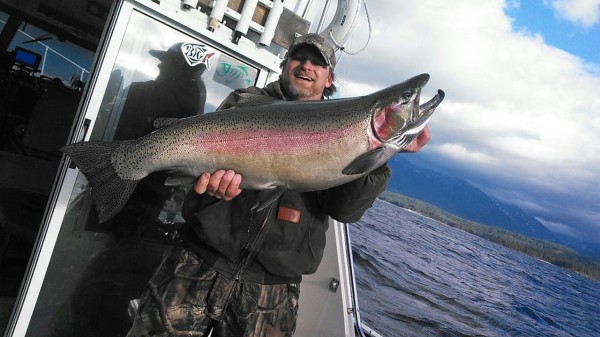
James Mullen caught this killer 22.38 LB. rainbow for 3rd place in the LPOIC Fall derby. Congrats buddy!
Click to view image



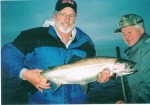
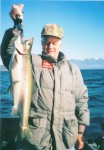
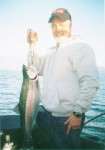
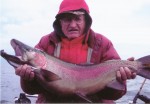

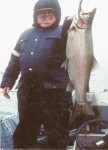
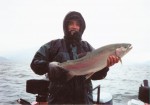


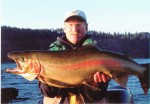

For anglers in Idaho's Panhandle Region and biologists alike, one of the greatest highlights of 2014 was watching scores of anglers enjoy great kokanee fishing on Lake Pend Oreille for just the second time in 15 years.
The north Idaho lake's population of kokanee - a land-locked version of ocean-going sockeye salmon -- had into the 1990s commonly provided harvests of a million fish or more. But the population begun to shrink, coincident with the fast-paced growth of lake trout. The larger lake trout preyed heavily on the smaller kokanee. Both kokanee and lake trout are non-native species introduced to the Pend Oreille system by humans.
State fishery officials were forced to close the kokanee fishery in Pend Oreille beginning in 2000 because of low population numbers. The lake serves as a water reservoir, backed by the U.S. Army Corps of Engineers' Albeni Falls Dam on the Pend Oreille River.
The low point of kokanee was an estimated abundance of fewer than 10,000 adult fish in 2007.
The IDFG decided to give the savory kokanee preference in the lake. The agency in 2006 launched programs to reduce the lake trout population in an attempt to limit predation on kokanee. The programs include both a reward system that offers anglers cash for removing lake trout from Pend Oreille and the contracting of professional fishers net the big predacious fish.
From 2006 through 2014, a total of 177,000 lake trout have been removed from Pend Oreille, 98,000 by the commercial netters and 79,000 by anglers, according to Andy Dux, the IDFG's principal research biologist for the project.
"We're happy with what's been accomplished," said Dux. The estimated adult lake trout in the lake has been reduced by about 80 percent since the removal program began in 2006; and the juvenile lake trout population reduced by about 77 percent since netting began to target those smaller fish in 2008.
Beginning this year, the spring-summer netting effort will be pared back, with research efforts concentrated on evaluating how the lake trout population reacts.
"We're trying to find the sweet spot," Dux said of an optimal level of lake trout management that will allow a continued flourishing of the kokanee population. The species has been on an upward trend.
The growth in the kokanee population allowed an opening in 2013 with a six-fish daily bag limit. With continued positive signs, that bag limit was increased to 15 fish last year. In the years prior to the 2000 closing, the bag limit was 25 fish.
The state is "thinking about staying at the 15-fish bag limit" this year, Dux said.
Anglers took notice and came out in droves last year. Preliminary estimates indicate that anglers harvested nearly 150,000 kokanee in 2014. Most of the fish caught are adults in the 3-4 year old range, and 10 to 11 inches long. They're not big, but are delicious.
"The quality of the meat is incredible," Dux said.
While that's a lot of fish, it was still only a fraction of the total adult population. Fish and game surveys indicated a population of 1.4 million adult kokanee, which is one of the highest estimates since the 1970s.
According to Dux, principal research biologist, fish and game's annual surveys indicate kokanee are poised to do well over the next few years. Juvenile kokanee were abundant, with fry and age-1 fish looking particularly strong. Age-2 kokanee were less abundant than the previous two years, but still appear to be a reasonably strong age group when compared to historical estimates.
These results provide an early sign that kokanee fishing should remain good in 2015 and beyond, the IDFG says.
The reduction in the lake trout production also appears to be helping the trophy rainbow trout population that cruises the lake. The population of so-called Kamloops or Gerrard-strain of rainbows have shown continued signs of improvement in 2014 and provided enjoyment for many anglers, the IDFG said.
As kokanee density has increased in recent years, so have rainbow trout growth rates.
"They feed almost exclusively on kokanee," Dux said.
Anglers caught more trophy rainbow trout in 2014 than they have in a long time, including many fish over 20 pounds. The lake record rainbow weighed 37 pounds, Dux said.
IDFG officials will present a summary of the Lake Pend Oreille fishery recovery efforts at the annual "State of the Lake" meeting this month in Sandpoint. In addition to an overview of the Pend Oreille fishery, officials will discuss the process of setting fishing regulations for 2016-2018. Fish and game is beginning the scoping phase of rulemaking where anglers are invited to present ideas.
The state agency says it doesn't see a need for any major rule changes this cycle, but is interested in what anglers have to say.
The main topics related to Lake Pend Oreille would be whether to reconsider the "unlimited rod" rule, which currently allows anglers to fish with multiple rods when fishing from a boat; and, whether or not to implement more restrictive rules on rainbow trout in order to improve the trophy fishery.
The meeting is scheduled for Thursday evening, Feb. 19 from 6:30 to 8:30 p.m. at the Ponderay Events Center by the Bonner Mall north of Sandpoint.
For more information, contact the Idaho Department of Fish and Game at (208) 769-1414.
From The Columbia Basin Bulletin at www.cbbulletin.com.

